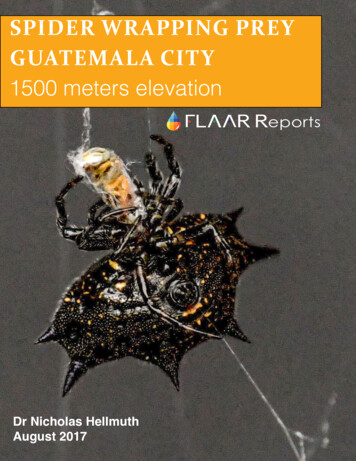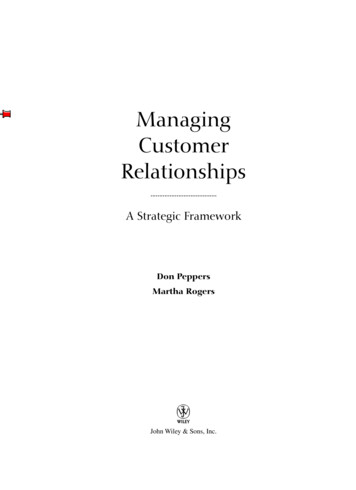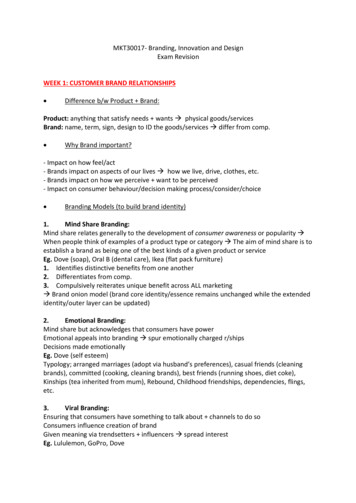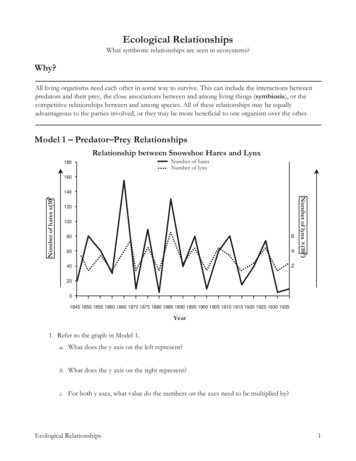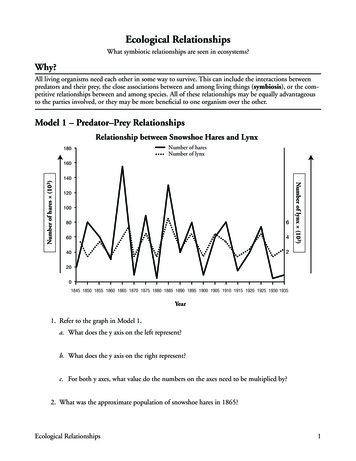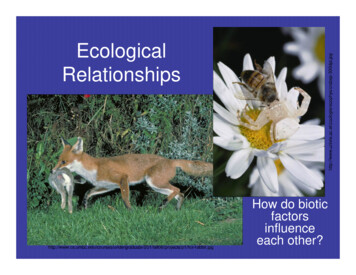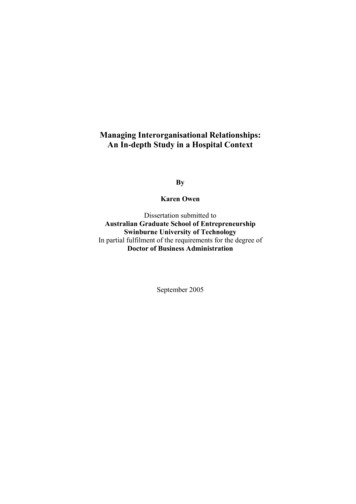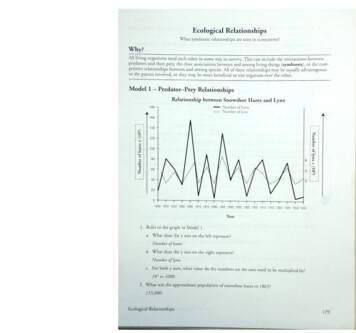
Transcription
EcologicalRelationshipsWhat symbiotic relationships are seen in ecosystems?Why?All living organisms need each other in some way to survive.This can include the interactions betweenpredators and their prey, the close associations between and among living things (symbiosis), or the competitive relationships between and among species. All of these relationships may be equally advantageousto the parties involved, or they may be more beneficialto one organism over the other.Model 1 —Predator—Prey RelationshipsRelationship between Snowshoe Hares and Lynx180Number of haresNumber of lynx160140120100806040201845 1850 1855 1860 1865 1870 1875 1880 1885 1890 1895 1900 1905 1910 1915 1920 19251930 1935Yearl. Refer to the graph in Model l.a. What does the y axis on che left represent?Number of hares.b. What does che y axis on the right represent?Number oflynx.c. For both y axes, what value do che numbers on the axes need to be multipliedby?103 or 1000.2. What was che approximatepopulation of snowshoehares in 1865?155,000.Ecological Relationships179
3. What was the approximate population of lynx in 1865?5000.4. When the number of snowshoe hares is high, what happens to the number of lynx? Use actualdata from the graph to support your observation.The number of lynx is usually also high (any data points acceptable).5. What happens to the population of lynx as the number of snowshoe hares decreases?Use actualdata from the graph to support your observation.The population oflynx declines also (any data points acceptable).6. Propose an explanation for the apparent cause and effect relationship between the populations oflynx and hares.Because a lot offood is available (snowshoehare) more lynx are likely to survive and their populationcan Increase.7. What does this information tell youa. about the effect of size of prey populations on the number of predators?If a largefood supply (prey) is available, then thepredator population can increase.b. about the effect of predators on the populations of their prey?Whenthe predatorpopulationbecomestoo large, they consumethe food(prey) andso the overallprey population is reduced.8. What other factor would influencethe size of the hare population in addition to the size of thepopulation of lynx?The amount offood available to the hares.STOP180POGIV' Activities for High School
Model 2 —SymbiosisSymbio ticRelationshipOrganism 1Organism 2Description of the relationshipDogFleaThe flea feeds on blood from the dog. There Parasitismis no benefit to the dog and che itching andbites may lead to infection.FungusAlgaeMutualismThe photosynthetic algaeprovide food forthe fungus, which in turn provides a suitableliving environment for the algae.TermiteCellulosedigestingThe bacteria in the gut of the termitebreakdown and feed on some of thecellulose taken in by the termite. Thetermite would be unable to digest cellulosewithout these bacteria and they gain anadditional source of nutrition from thesurplus digested cellulose.MutualismbacteriaSharkRemoraThe Remora fish swim alongside the sharkand cake scraps of food that the shark dropsduring feeding. The shark does not eat cheRemora and appears unaffected by itspresence.CommensalismCaccleCattle egretThe cattle egret follows herds of cattle andeats the insects that the cattle stir up as theymove through the grassland. The cattleappear to be unaffected by the egrets.CommensalismHumanTapewormThe tapeworm lives in che small intestineswhere it feeds and grows, robbing thehuman of essential nutrients.Pa rasitism9. Refer co the information given in Model 2.a. In the dog and flea relationship,is there a benefit for one of the organismsor for both?Only one—theflea.b. Is either the dog or the flea harmed by chis relationship?The dog is harmed.c. Which other relationship in Model 2 is similar to chat between the dog and flea?Human and tapeworm.Ecological Relationships181
10. Refer to the fungus and algae relationship in Model 2.a. Is there a benefit for one of the organisms or for both?Both.b. Is either the fungus or the algae harmed by this relationship?No.c. Which ocher relationship in Model 2 is similar co that between the fungus and the algae?Termite and cellulose-digesting bacteria.I l. Refer co the shark and remora relationship in Model 2.a. In che shark and remora relationship, is there a benefit for one of the organisms or for both?Only one benefits, the remora.b. Is either the shark or the remora harmed by chis relationship?c. Which other relationship in Model 2 is similar co that between the shark and che remora?Cattle and cattle egret.Read This!Symbiotic relationships are identified by how they affect the organisms involved. The three types of symbiotic relationships are listed below.Mutualism: Both organisms benefit from the relationship. Parasitism: One organism benefits and the ocher is harmed. Commensalism: One organism benefits and there is no effect on che other.12. Using the information from che Read This!box, label each of the relationships in Model 2 asmutualism, parasitismor commensalism.See Model 2.13. With your group, choose one of the organism pairs from Model 2 and justify why you categorized the relationship as you did.Answers will vary. Students sh01dd explain how the description meets the definition of the symbioticrelationship.STOP182POGIIP' Activities for High School Biology
Model 3 —Inter- and Intra-specific CompetitionGraph AGraph BP. aurelia and P. caudatum grown togetherP. aurelia and P. caudatum grown separatelyP. aureliaoc:OP. aurelia3OP. coudatumP. coudatumNumber of Days20Number of Days20Graph CRate of growth of R. tigrina tadpoles in populations of different sizes.1.00.8A—Minimum mass neededfor metamorphosis0.6to occur.5 individuals0.440 individuals0.260 individuals — — —160 individuals01 2345678Time (weeks)9 1014. What are the names of che species in graphs A and B in Model 3?P. aurelia and P. caudatum.15. Which graph shows competition between two different species?16. Which graph in Model 3 shows population growth for only one species?17. What is the difference between the growing conditions in graph A and graph B?In graph A the two speciesare grown separatelyand in graph B they are grown together.Ecological Relationships183
18. I? caudatum and I? aurelia are both species of Paramecium, a microscopic protozoan. P. caudatumis the larger of the two species. When grown separately,which of the two species reaches a largerrelative population size after 20 days?After 20 days P. aurelia reaches a larger population.19. When grown separately is there a substantial difference in the relative population size of the twotypes of paramecia after 20 days?While some difference is seen, it is not significant.20. Compare graphs A and B in Model 3.a. Which population of species of Parameciumis more affected when the two species are growntogether?Thepopulation on. caudacum is dramatically affectedwhen it is grown with P. aurelia, zvhereaslittle effectis seen on the relativepopulation size on. aurelia when grown together with P. caudacum.b. Considering that I? caudatum is 50% larger in size than P. aurelia, develop a hypothesis withyour group to explain why interspecific competition has an effect on the relative populationsize of I? caudatum.The larger species(P. caudacum) requires more nutrients to survive. It is unable to compete withthe smaller speciesthat has a lower nutrient requirement.21. In a grammatically correct sentence, define interspecific competition.Interspecific competition is competition between two or more different species of organisms.22. Refer to graph C in Model 3.a. Describe the species of organism represented by the graph.Tadpolesof R. tigrini.b. These tadpoles are confined to a limited environment. What are they all competing for in thatenvironment?Food, space.23. What is che minimum mean body mass required for metamorphosis of a tadpole to occur?Approximately 0.75 g.24. When there are only five tadpoles, how long does it take for metamorphosis to occur?Between2 and 3 weeks.25. When the number of individuals is increased to 60, what is the effect on the time taken formetamorphosis to occur?It increases to 6 weeks.26. When the number of individuals is increased to 160, what is the effect on the time takenformetamorphosis to occur?It increaseseven more to between 8 and 9 weeks184POGILTMActivities for High School Biology
27. Propose an explanation for why the population size affects the number of weeks before metamorphosis of che tadpoles occurs.The tadpoles are all competingfor limited amounts offood so they will not be able to grow as quicklyand reach the minimum size requiredfor metamorphosis.28. The type of competition represented by graph C is referred to as intraspecific competition.NV11atis different about chis compared to the competition seen in graph B?Intraspecifc competition only involves one species.STOPEcological Relationships185
Extension Question29. An investigation was carried out into competition between two species of grass, Bromus madritensis and B. rigidus. Equal numbers of seeds of B. madritensis were sown in a number of differentpots. In each pot, an equal number of seeds of B. rigiduswas then sown a different number ofdays after B, madritensis. The results are shown in the graph below.Given that the total dry mass of plant material was the same in each pot, summarize the mainconclusions that can be drawn from this investigation. Suggest an explanation for the resultswhen the delay before sowing B. rigidus was 30 days.10080PercentagecontributionofB. madritensisto total dry mass60after 45 days20102030Delay before planting B. rtgidus/daysWhen grown togetherfom day one, B. rigidus was able to out-compete B. madritensis, which onlyaccountsfor 20 0/0 of the total mass after 45 days. When the time taken to plant B. rigidus is increased,the B. madritensis is able to gain a competitive advantage and eventually out-competes the B. rigidus.If the delay is 30 days, then the B. rigidus is not able to grow at all and the B. madritensis accountsfor 100 0/0 ofthe dry mass after 45 days.186POGIL TNActivities for High School Biology
Symbiotic relationships are identified by how they affect the organisms involved. The three types of sym-biotic relationships are listed below. Mutualism: Both organisms benefit from the relationship. Parasitism: One organism benefits and the ocher is harmed. Commensalism: One organism benefits and there is no effect on che other. 12. Using the information from che Read This! box, label each of

